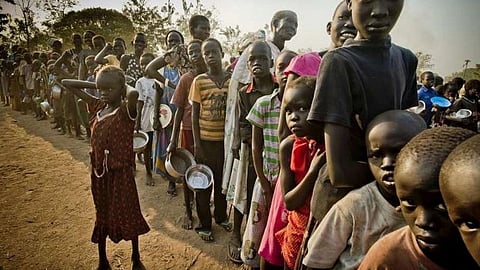Emerging economic nodes and resource competition amid geopolitical tensions
Extreme weather events are considered one of the top risks in the World Economic Forum’s (WEF) Global Risks Report 2025. Looking 10 years ahead, the WEF’s top three risks are all environmental – extreme weather events, bio-diversity loss with an ecosystem collapse and critical change to earth systems.
“Mass migration from conflict and climate change is putting pressures on governments, with political tensions and protests potentially escalating into civil unrest, leading to potential disruptions in operations and supply chains,” informs a report on top geopolitical risks, released this year by KPMG.
As many countries attempt transition to green energy, while also growing their technology sectors, there is increased competition for critical resources such as battery components. “We have witnessed a ‘scramble’ for minerals in Africa, with a similar story in Latin America, which holds 68 per cent and 36 per cent respectively of the world’s lithium and copper reserves,” the report adds.
With recent geopolitical tensions on the rise, countries and territories are adopting protectionist measures to safeguard and diversify their minerals supply chains. This impacts many countries which are dependent on a small number of suppliers for critical minerals to drive their energy, technology (especially AI) and defence industries.
The report states that South-east Asian countries, especially Vietnam, Indonesia and Malaysia, have benefited the most from the search for new sources, buoyed by their sizeable raw materials sector and related industries. As they scale up their domestic production, these newer regions are expected to become prominent global suppliers of critical raw materials.
Meanwhile, consistent economic growth is likely to continue to put pressure on energy, food and water resources, as well as infrastructure, housing and technology, as part of a broader demand for products and resources. The World Bank estimates that demand for food will rise by 50 per cent by 2030, because of the growing world population, rising affluence and a shift to Western dietary preferences in emerging nations. Lack of access to stable supplies of water is reaching critical proportions, particularly for agricultural purposes, exacerbated by rapid urbanisation.
Additionally, climate change, pollution and nature degradation could reduce the availability of suitable land, pollinators and bio-diversity, which could limit food production and lead to geopolitical instability. Such shortages can threaten supply chains for agri-businesses, reduce water supplies for manufacturers and create greater economic and political instability in the affected countries.
Access to water and the quality of water has also emerged as issues causing geopolitical stress, due to their impact on issues such as migration, food and health. “Prioritisation of water resources has now become a domestic and global security essential,” says Mike Hayes, leader, global head, renewable energy, climate change & decarbonisation, KPMG International.
New economic nodes
While the US remains a dominant economic financial power, the world is witnessing the emergence of new economic nodes in regions, such as the Middle East, along with attempts to diversify capital markets away from dollar-dominated ones through BRICS. Companies are also investing in alternative manufacturing or trading hubs in Southeast Asia – be they Indonesia, Malaysia, Singapore, Thailand or Vietnam – as a potential alternative to China.
In 2023, Dubai attracted the most greenfield foreign direct investment (FDI) projects (1,077) the world over, with Singapore in second place (442), just ahead of London.
There have also been discussions among the BRICS nations about establishing a new reserve currency, but tariff threats from the US haven’t led to major headway. As opportunities for global businesses pivot to new regions, national policies may impose barriers to historic trading routes. But they also create opportunities for businesses, agile enough to reconfigure their supply chains around new locations in Asia, Africa and Latin America.
“Some companies may even choose to relocate to the US to get closer to the market, avoid punishing import taxes and take advantage of possible lower domestic taxes,” says the report. “This could strengthen the US manufacturing base and benefit the country’s upstream suppliers”.
The slowing down or re-ordering of globalisation, along with geopolitical interests, rather than economic efficiency considerations, can still drive closer regional ties. Regional trade agreements and economic partnerships, such as Comprehensive & Progressive Agreement for Trans-Pacific Partnership (CPTPP), Regional Comprehensive Economic Partnership (RCEP) and the African Continental Free Trade Area (AfCFTA), all have the potential to boost economic growth and foster regional co-operation.
Also, there are signs that China is strengthening trade relations and economic ties with many Latin American countries, with a major shipping company opening a massive port in Peru, which can accommodate the world’s largest container ships. “National policies may impose barriers to holistic trading routes, but they also create opportunities for businesses to reconfigure their supply chains, adopting innovative technology and additive manufacturing advancements,” says Jonathon Gill, global head, industrial manufacturing & defence, KPMG International.

